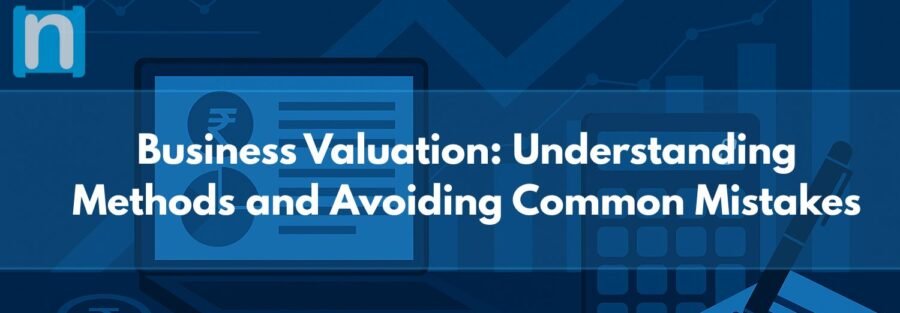Business Valuation: Understanding Methods and Avoiding Common Mistakes
Table of Contents
ToggleBusiness valuation lies at the heart of informed decision‑making—whether you’re raising capital, planning a sale, or guiding strategic growth. At N Pahilwani & Associates, we deliver clarity, credibility, and confidence—helping you understand how to assess business valuation, apply the right valuation methods, and sidestep the most common pitfalls.
What is Business Valuation?
Business valuation is the process of determining the economic worth of a company by assessing its financial performance, assets, liabilities, market position, and future growth potential. It is more than just a number—it’s an analytical approach that helps stakeholders make informed decisions.
At N Pahilwani & Associates, we treat business valuation as a strategic exercise. We blend financial analysis, industry benchmarks, and forward-looking insights to deliver valuations that are accurate, transparent, and defensible.
Why Business Valuation Matters
Whether you are selling a company, raising investment, or planning internal growth, business valuation plays a critical role in:
- Mergers & Acquisitions – Establishing a fair market value to guide negotiations.
- Investor Fundraising – Presenting credible numbers that attract and reassure investors.
- Strategic Planning – Identifying value drivers and areas for improvement.
- Regulatory & Tax Purposes – Meeting compliance requirements with accurate documentation.
- Exit Planning – Ensuring you receive maximum value when selling.
Key Methods of Business Valuation
1. Income Approach (e.g., Discounted Cash Flow – DCF)
What it is:
Estimates the present value of a business by projecting future cash flows and discounting them using an appropriate rate, often the weighted average cost of capital. This method captures the intrinsic value based on long-term earning potential.
Best for:
Stable, established businesses with predictable revenues and consistent profit margins.
Watch out for:
Over-optimistic growth forecasts or using an incorrect discount rate can significantly skew results. Even minor assumption changes can impact valuation.
2. Market Approach (Comparable Company or Transaction Method)
What it is:
Values the business by comparing it to similar companies or past transactions, applying industry-specific valuation multiples like EV/EBITDA or P/E ratio. Adjustments are made for size, profitability, and risk differences.
Best for:
Industries with abundant, reliable comparable data and active M&A activity.
Watch out for:
Differences in accounting standards, market trends, or growth prospects can make comparisons misleading. Proper normalization is essential.
3. Asset-Based Approach
What it is:
Determines the company’s net asset value by subtracting total liabilities from the fair market value of all assets—both tangible (machinery, property) and intangible (patents, brand). Can be adjusted for liquidation or going-concern scenarios.
Best for:
Asset-heavy businesses, holding companies, or situations involving liquidation or restructuring.
Watch out for:
Risk of undervaluing intangibles like goodwill, brand equity, and customer relationships. Asset revaluation is often necessary for accuracy.
Common Mistakes to Avoid in Business Valuation
- Relying on a Single Method – Cross-check results using multiple approaches for a well-rounded view.
- Using Inaccurate Financial Data – Poor record-keeping and unadjusted earnings distort valuations.
- Ignoring Intangible Assets – Brands, IP, and goodwill can significantly influence value.
- Misjudging Market Conditions – External economic trends can impact the final figure.
- Overestimating Future Growth – Unrealistic projections can lead to inflated valuations.
- DIY Valuations Without Expert Help – Professional expertise ensures accuracy and credibility.
Best Practices – N Pahilwani & Associates’s Recommendations
- Define the purpose of your valuation before choosing a method.
- Use multiple approaches (income, market, and asset-based) to validate results.
- Maintain accurate financial records to ensure reliable analysis.
- Adjust for industry-specific factors that could affect comparability.
- Factor in both tangible and intangible assets for a complete picture.
- Seek professional guidance to ensure defensible and transparent outcomes.
Summary Table
| Valuation Method | When to Use | Key Considerations |
| Income Approach | Predictable earnings businesses | Discount rate accuracy, realistic projections |
| Market Approach | Industries with comparable companies | Adjust for differences in market and accounting |
| Asset-Based Approach | Asset-heavy or liquidation scenarios | Include both tangible and intangible assets |
Conclusion
A well-executed business valuation empowers you to make strategic, informed, and confident business decisions. By understanding the different methods and avoiding common mistakes, you can ensure that your company’s value reflects its true potential.
At N Pahilwani & Associates, we combine proven valuation techniques with deep industry expertise to help you achieve accurate, credible, and actionable results. Whether you’re selling, expanding, or planning for the future, our team is ready to guide you every step of the way.




